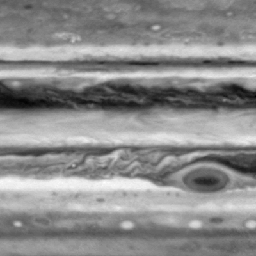This brief movie shows counterclockwise atmospheric motion around Jupiter's Great Red Spot. The clip was made from blue-filter images taken with the narrow-angle camera on NASA's Cassini spacecraft during seven separate rotations of Jupiter between Oct. 1 and Oct. 5, 2000.
The clip also shows the eastward and westward motion of the zonal jets, seen as the horizontal stripes flowing in opposite directions. The zonal jets circle the planet. As far as can be determined from both Earth-based and spacecraft measurements, the positions and speeds of the jets have not changed for 100 years. Since Jupiter is a fluid planet without a solid boundary, the jet speeds are measured relative to Jupiter's magnetic field, which rotates, wobbling like a top because of its tilt, every 9 hours 55.5 minutes. The movie shows motions in the magnetic reference frame, so winds to the west correspond to features that are rotating a little slower than the magnetic field, and eastward winds correspond to features rotating a little faster.
Because the Red Spot is in the southern hemisphere, the direction of motion indicates it is a high-pressure center. Small bright clouds appear suddenly to the west of the Great Red Spot. Scientists suspect these small white features are lightning storms. The storms eventually merge with the Red Spot and surrounding jets, and may be the main energy source for the large-scale features.
The smallest features in the movie are about 500 kilometers (about 300 miles) across. The spacing of the movie frames in time is not uniform; some consecutive images are separated by two Jupiter rotations, and some by one. The images have been re-projected using a simple cylindrical map projection. They show an area from 50 degrees north of Jupiter's equator to 50 degrees south, extending 100 degrees east-west, about one quarter of Jupiter's circumference.
Cassini is a cooperative project of NASA, the European Space Agency and the Italian Space Agency. The Jet Propulsion Laboratory, a division of the California Institute of Technology in Pasadena, manages the Cassini mission for NASA's Office of Space Science, Washington, D.C.

 Planetary Data System
Planetary Data System












